6 Insider Keys to Strong, Wide Shoulders
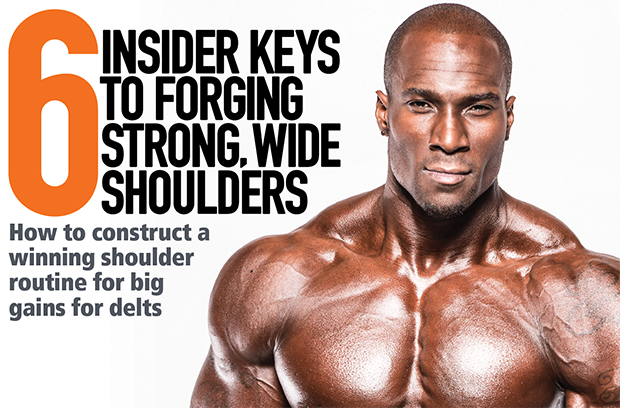
How to construct a winning shoulder routine for advanced mass gains
The weight of the world, it seems, is a fairly heavy load. After all, that’s what Atlas was forced to bear upon his shoulders, according to ancient Greek mythology, as punishment for a failed rebellion against Zeus. While that’s one way to build big, broad shoulders, let’s be clear: You don’t have to resort to combating the gods to build delts that are of mythological dimension. Let’s instead go step-by-step through a better, modern-day approach.
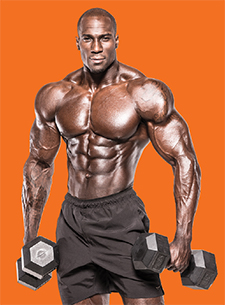
Nuts and Bolts of a Great Shoulder Routine
1. Do an Overhead Press First.
As with all body parts, start off with multi-joint exercise(s)—those movements that engage the greatest amount of muscle mass and allow you to use the heaviest loads—when your energy levels are highest. This family of overhead presses, especially when done in the appropriate rep range for growth, stimulates muscle-building anabolic hormones most effectively, optimizing potential gains.
You can do an overhead press with a barbell, dumbbells, or machine, and there are a number of variations that target the middle and front delts somewhat differently. If you want to prioritize middle-delt growth, choose a variation in which your elbows go straight out to your sides during execution. In the long run, you’ll want to try various alternatives both to optimize overall muscle size (each works the target musculature slightly differently) and to introduce variety into your routine.
If you want to emphasize strength in your shoulder workout, this is the exercise where you want to add slightly more weight to push the reps into that lower range (typically 4 to 6).
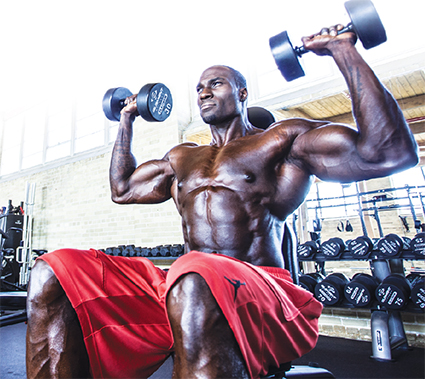
2. Add an Upright Row.
Adding a second compound movement isn’t required, but if your shoulders are lagging, it’s a worthy short-term fix. Again, because it’s multi-joint and those movements are linked to superior anabolic hormone release, do it toward the front end of your workout as you’ll be able to use heavier loads than if you did it last.
Upright rows can be used with nearly any kind of equipment in the gym, including cables. As with overhead presses, the more your elbows go directly out to your sides, the more emphasis the middle delts get; a close grip pulls your elbows somewhat forward, which shifts some of the stimulus to the front delts.

3. Follow with an Isolation Move for Each Delt Head.
Single-joint exercises eliminate assisting muscle groups, so here’s where you can do a move to focus on each of the delt heads, but you’ll have to back off the relatively heavy loads you used for overhead presses and upright rows. To focus on an individual head, you must train in the particular plane in which that delt is engaged most actively:
When you’re standing erect and you raise your extended (but not locked out) arms directly in front of your body, you emphasize the anterior (front) delts; When you’re standing erect and you raise your extended arms directly out to your sides, you target the middle delts; And when you bend over and bring your extended arms from a position below your body out to your side as wide and high as possible, you’re focusing on the posterior (rear) delts.With single-joint moves, train toward the upper end of the muscle-building rep range; that is, choose a weight in which you can do 10 to 12 reps per set. These aren’t the types of exercises in which you should try very heavy weights because of the stress that’s placed on the elbow joint. The goal here is to thoroughly work the delt heads in an effort to completely fatigue them and generate a significant muscle pump.
If you have one particular head that’s lagging, do it first in order of these three movement planes. If your delts are fairly well balanced, rotate which movement comes first from one workout to the next. In general, you become more fatigued over the course of your training session, so if you always do one type of movement last, it’s going to start to lag over time.

4. Add Intensity Boosters for Advanced Development.
Working past the point of initial muscle failure can more significantly tax the muscle fibres, leading to a great degree of damage and muscle burn, effectively boosting muscle growth if not overdone. Here are some of the best intensity techniques that can be done on shoulder day. Don’t do them on every set; we recommend one on just 1 or 2 sets of each movement, preferably your last or heaviest set(s).
Rest-Pause. Using a weight you can do for just 8 reps, complete only 5, rest 20 seconds, and do another set of 5. Continue this pattern until you can no longer complete 5 reps. That’s one set. Here, you’ll want to choose a movement that’s easy to get into and out of the start position. That makes, for example, overhead dumbbell presses a bad choice.
Forced Reps. After you reach muscle failure, your partner gives you just enough assistance to get over the sticking point for a few additional reps that you wouldn’t have been able to complete on your own.
Drop Sets. After you reach muscle failure, immediately reduce the poundage by 20 to 30 percent and continue on to a second point of muscle failure.
Extended Sets. Start with a more difficult variation or an exercise, then when you reach muscle failure, switch to a similar movement in which it’s easier so you can compete more reps. For example, if you do seated lateral raises on a bench, it’s very difficult to use momentum. After you reach middle-delt muscle failure, go right into that standing version, which allows you to add some body English through your lower body. You’ll be able to do more total reps with a given weight this way.
Some of these advanced techniques are better for building strength (rest-pause, eccentrics) and others for pumping the muscle (drop sets, extended sets). The longer you train, the more you’ll want to experiment with such techniques as a way to change up the training stimulus.
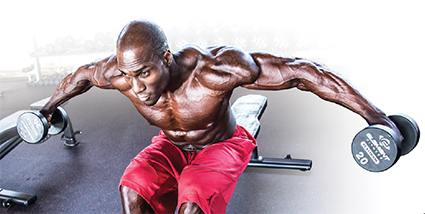
5. Variety Is the Spice of Continued Muscle Growth.
A great workout takes about two months before it becomes stale and muscle gains slow. That is, the muscles have adapted to the training stimulus and doing more of the same won’t result if significantly further gains. That’s your sign that it’s time to make some changes in your training. While there are a number of ways to implement change (exercises, exercise order, volume, weight vs. reps, rest periods, advanced techniques), we’ll focus here on exercise substitution.
Inserting slightly differently exercises allows the target musculature to get worked from somewhat different angles for more optimal overall development. When adding in different exercises to your current routine, it also ensures you’re less likely to adapt to a particular routine as quickly, meaning that you can continue making gains for a longer period. What’s more, you’ll find the changes mentally stimulating.
We already mentioned variations for the multi-joint overhead press and upright row, but here are some to consider for each of the three delt heads.
Front Delt. EZ-bar or straight bar front raise, bilateral or single-arm front dumbbell or cable raise, machine front raises (one arm). One drawback to alternating front raises is that as one side works, the other rests, reducing what’s called time under tension. If you instead move the “rest” spot to the top position, you’ll make it more challenging and introduce variety.
Middle Delt. Besides the common standing dumbbell lateral raise, which you can do bilaterally or unilaterally, you can also do it seated or leaning from a post. Of course, there are machine and cable lateral raises (the latter is done one arm at a time). Lateral raises using an EZ-bar or short barbell put more stress on the stabilizer muscles, which often comes at the expense of load, making them inferior to the aforementioned variations.
Rear Delt. Do lateral raises from the bent-over position with either one or both arms, but they can also be done seated. The cable version can be done from the bent-over position (one arm) as well as standing using the upper pulleys. The reverse flye on the pec-deck machine duplicates the movement pattern but is done seated upright and locks your arms in the correct slightly bent position.

6. Rx for an Underdeveloped Delt Head.
Earlier we mentioned how to offset disproportionate delt development by choosing exercise variations and how they’re placed in your workout order. Another important consideration is to add a secondsingle-joint exercise for a given head to your workout, a short-term strategy that can help bring it up.
Say you’re already doing bent-over lateral raises for rear delts earlier in your routine, but you’d like to do a little more for them. Adding a second exercise from a slightly different angle adds more stress, but the muscle-recruitment pattern is slightly different, which aids over rear-delt development. Here the reverse pec deck or standing reverse cable flye are good options.
Two points here:
Do the free-weight version as your first move, the machine version last. As you become highly fatigued, machine movements typically reduce the need for stabilizers, allowing you to better focus on taking the target muscle to failure.
Second, use different relative intensities because that also introduces a different training stimulus on the muscle. That essentially means using a weight in which you can do 8 to 10 reps to failure on the first movement and 10 to 12 on the second. Of course, you can use the same strategy if you do a second overhead press in your routine as well.
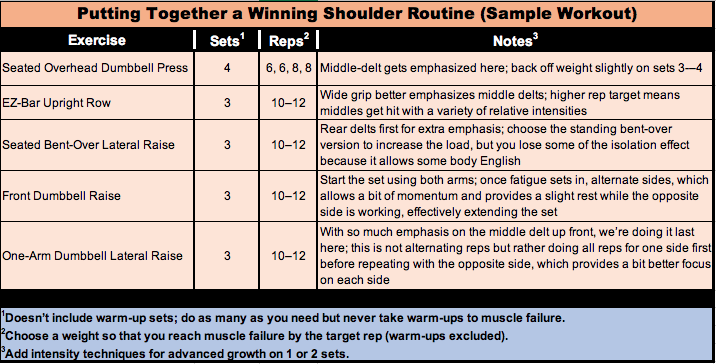 OVERHEAD DUMBBELL PRESS
OVERHEAD DUMBBELL PRESS
INSIDER’S TIP
With your elbows out to your sides, this effectively emphasizes the middle delts. Get a spotter both to help get the weights into position but also to push to failure—and beyond—without the threat of losing control of the dumbbells.
EZ-BAR UPRIGHT ROW
INSIDER’S TIP
A wider grip ensures the elbows go straight out to your sides, which tells you the middle delts are engaged most effectively.
SEATED BENT-OVER LATERAL RAISE
INSIDER’S TIP
The seated position reduces momentum, but be careful of raising up out of the bent-over position, which would make these more like seated lateral raises, which shifts the emphasis from the rear to middle delt.
FRONT DUMBBELL RAISE
INSIDER’S TIP
Don’t bend your elbows too much; doing so increases the tension on the middle delts at the expense of the fronts. Also, take the motion above the parallel position to extend the range of motion.
ONE-ARM DUMBBELL LATERAL RAISE
INSIDER’S TIP
Instead of taking the weight to shoulder level, try bringing it about 30 degrees above the parallel as the middle delt is still strongly contracting. This exercise also hits the upper traps, one reason many bodybuilders do upper traps after delts. Make extra sure your elbow is locked in the slightly bent position for the duration of the movement; opening and closing at the elbow means the triceps are being recruited.

